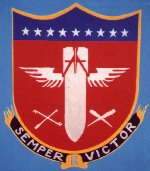|
The
B-29 Superfortress was the most complicated and the most
expensive weapon of WWII. This big bomber with long legs
brought the war to the home islands of Japan. In its early
development the B-29 bad a number of problems with the
major ones connected to unreliable engines that had a
nasty habit of catching fire on a moment's notice. After
much work the engine problems were solved and the B-29
went on to become a fearsome weapon of destruction. The
20th Air Force flew the longest combat missions ever attempted
under demanding conditions such as very long distances
over water and troublesome weather fronts.
During
the last nine months of the war the 20th Air Force flew
3331 combat missions (24,665 bombing sorties) dropping
155,041 tons of bombs and mines; 318 B-29's were lost.
The Japanese Air Force lost 377 planes with 245 probables,
and 417 aircraft badly damaged.
In
addition to the combat missions, the following sorties
were flown against Japan: 405 weather sorties, 180 weather
and recon sorties, 106 weather and leaflet sorties, 110
sea search sorties, 150 radar and photo recon sorties,
73 radar scope sorties and 9 photo recon sorties. Seven
additional B-29's were lost on weather and leaflet sorties.
The
Third Photo Recon Squadron flew 427 photo recon sorties
and lost 6 aircraft. Thirty-one recon sorties were flow
by B-24's.
Between
June of 1944 and August 1945, B-29's flew a combined 380
bombing missions (26,611 bomb sorties) and dropped 167,448
tons of bombs and mines and lost 402 B-29's while shooting
down 871 enemy aircraft as well as 565 probables and damaging
1,090.
Perhaps
the greatest accomplishments of the 20th AF was during
the last five months of the war. Five major industrial
areas received 44.1 percent of all the 20th Air Force
tonnage. These industrial centers were Tokyo, Osaka, Nagoya,
Yokohoma, and Kobe. Damage to these areas ranged from
25 per cent in Osaka to 43 per cent in Nagoya. The aircraft
industry in those areas was 50 per cent destroyed. The
industrial area of Kobe was 41 per cent destroyed. The
area gutted by these strikes was 103.22 square miles.
These major industries were considered to be essentially
out of the war.
Sixty-four
other cities were burned to the ground. About 72 square
miles of urban areas in these cities were completely destroyed.
Takamatsu was 89.3 per cent destroyed. Low level raids
ordered by General Curtis Le May burned out 175 square
miles of urban area in 69 cities leaving over 9,000,000
people homeless.
The
20th Air Force had taken a promising but untried bomber
and turned it into an efficient and awesome weapon of
destruction. Such a capacity to wage war and the terrible
destruction that the B-29 brought to the Japanese Empire
brought unconditional surrender to Japan. The two atomic
bombs ended the war and were a "face-saver" to a nation
that was totally beaten and demoralized.
The
accomplishments of the 20th Air Force will stand as a
high point in military aviation.
*Material
taken from Over and Under, John Misterly, Jr. Carlton
Press, Inc. New York, New York.
|



